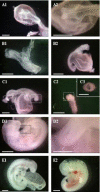Human neural tube defects: developmental biology, epidemiology, and genetics
- PMID: 15939212
- PMCID: PMC2727639
- DOI: 10.1016/j.ntt.2004.12.007
Human neural tube defects: developmental biology, epidemiology, and genetics
Abstract
Birth defects (congenital anomalies) are the leading cause of death in babies under 1 year of age. Neural tube defects (NTD), with a birth incidence of approximately 1/1000 in American Caucasians, are the second most common type of birth defect after congenital heart defects. The most common presentations of NTD are spina bifida and anencephaly. The etiologies of NTDs are complex, with both genetic and environmental factors implicated. In this manuscript, we review the evidence for genetic etiology and for environmental influences, and we present current views on the developmental processes involved in human neural tube closure.
Figures

References
-
- Antony AC. The biological chemistry of folate receptors. Blood. 1992;79:2807–2820. - PubMed
-
- Baldwin CT, Hoth CF, Macina RA, Milunsky A. Mutations in PAX3 that cause Waardenburg syndrome type I: ten new mutations and review of the literature. Am J Med Genet. 1995;58:115–122. - PubMed
-
- Bekman E, Henrique D. Embryonic expression of three mouse genes with homology to the Drosophila melanogaster prickle gene. Gene Expr Patterns. 2002;2:73–77. - PubMed
-
- Blackshear PJ, Tuttle JS, Oakey RJ, Seldin MF, Chery M, Phillipe C, Stumpo DJ. Chromosomal mapping of the human (MACS) and mouse (Macs) genes encoding the MARCKS protein. Genomics. 1992;14:168–174. - PubMed
-
- Borycki AG, Li J, Jin F, Emerson CP, Epstein JA. Pax3 functions in cell survival and in pax7 regulation. Development. 1999;126:1665–1674. - PubMed
Publication types
MeSH terms
Grants and funding
LinkOut - more resources
Full Text Sources
Medical

